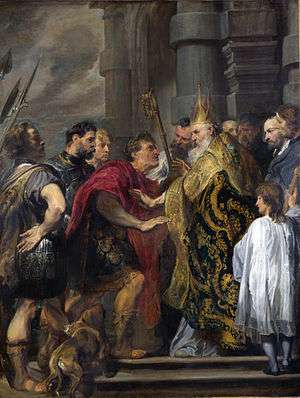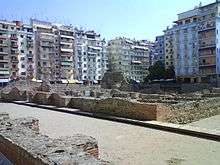Massacre of Thessalonica
The Massacre of Thessalonica was an atrocity carried out by Gothic troops under the Roman Emperor Theodosius I in 390 against the inhabitants of Thessalonica, who had risen in revolt against the Gothic troops.
| Massacre of Thessalonica | |
|---|---|
 | |
| Location | Thessalonica, Roman Empire |
| Date | 390 |
| Target | Rioters |
Attack type | Massacre |
| Deaths | 7,000 |
| Victims | Citizens of Thessalonica |
| Perpetrators | (Gothic) Eastern Roman army on orders by Theodosius I |
| Motive | To quell an anti-Germanic revolt |
Massacre
In April 390, Butheric, a Gothic magister militum in command of Illyricum (which included Thessalonica), had a popular charioteer arrested for a homosexual offence.[1] The populace demanded the charioteer's release and, as Butheric refused, a general revolt ensued which cost Butheric his life. As soon as Theodosius heard of the uprising he was enraged, and ordered an immediate retaliation. The army units sent to Thessalonica acted as if they had captured a hostile city and massacred several thousands of its inhabitants. Church historian Theodoretus puts the figure at about 7,000, saying:
The anger of the Emperor rose to the highest pitch, and he gratified his vindictive desire for vengeance by unsheathing the sword most unjustly and tyrannically against all, slaying the innocent and guilty alike. It is said seven thousand perished without any forms of law, and without even having judicial sentence passed upon them; but that, like ears of wheat in the time of harvest, they were alike cut down.[2]
Although the Emperor changed his mind rather quickly and sent another messenger to cancel his previous order and to prevent the troops from massacring the inhabitants of the city, this revocation came too late.
Aftermath

Ambrose, the bishop of Milan, after hearing about the massacre, left Milan (which was the residence of Theodosius at that time) and refused to celebrate a Mass in the Emperor's presence, until Theodosius repented. In a letter to the emperor, Ambrose explained his position and gave reasons for his resolution:
What could I do? Should I not hear? But I could not clog my ears with wax, as old fables tell. Should I then speak about what I heard? But I was obliged to avoid precisely what I feared could be brought about by your orders, that is, a bloodshed. Should I remain silent? But then the worst thing would happen as my conscience would be bound and my words taken away. And where would they be then? When a priest does not talk to a sinner, then the sinner will die in his sin, and the priest will be guilty because he failed to correct him.[3]
According to Theodoret, when the emperor tried to enter a Milanese church, where Ambrose was about to celebrate a Mass, the bishop stopped him and rebuked him for what he had done. And because the emperor “had been brought up according to divine words and understood well that some affairs are handled by priests, others by emperors”, he could do nothing but return "weeping and sighing" to the palace.[4] Eight months had passed and Theodosius still sat in the palace, moaning and sobbing. His magister officiorum Rufinus, who "used great freedom of speech due to the familiarity with the emperor", noticed this behaviour, approached and asked him why he was weeping. Having been told, he volunteered to see the bishop and ask him to reconsider. Theodosius hesitantly agreed and even chose to follow Rufinus from a distance. Ambrose was not restrained at all when negotiating with Rufinus, scolding him and even accusing him of complicity in the massacre: "Rufinus, you are as impudent as a dog, because it was you who advised the emperor such a bloodshed." When the emperor showed up, Ambrose at first remained stubborn and changed his mind only after Theodosius promised to promulgate a law, which in cases of death sentences would introduce a thirty-day lag before the execution.[5]
References
- Sozomenus, Ecclesiastical History 7.25
- Theodoretus, Ecclesiastical History 5.17
- Ambrose, ep. 51.3
- Theodoret, Historia ecclesiastica 5.17
- This law is extant, but the problem is that it was issued in 382 already (see CTh 9.40.13) jointly by Theodosius, Valentinian II and Gratian.
Bibliography
The massacre is treated in all accounts of Theodosius' reign, including:
- A. Lippold: Theodosius der Große und seine Zeit. 2nd ed., München 1980, p. 40ff.
- J. Norwich, Byzantium: The Early Centuries, p. 112.
- E. Gibbon, The Decline and Fall of the Roman Empire, ch.27 2:56
- A. Demandt: Magister Militum. In: Pauly-Wissowa. Paulys Realencyclopädie der classischen Altertumswissenschaft (neue Bearbeitung). Supplementband XII, Sp. 717 - Butherichh and Theodosius
See also:
- P. Heather, Goths and Romans, 332-489. Oxford 1991, p. 184.
- A. Schwarz, Reichsangehörige Personen gotischer Herkunft. Wien 1984, s.v. Butherichus.
Primary sources for this event:
- Theodoret, Historia ecclesiastica 5.17
- Sozomenus, Historia ecclesiastica 7.25.1-7
- Cassiodorus, Historia ecclesiastica 9.30
- Ambrose, epistola 51
- Ambrose, De obitu Theodosii 34
Later historical works:
- Joannes Malalas, Chronographia 13.43
- Theophanes the Confessor, Chronographia 1.72-3
- Cedrenus, Compendium historiarum 1.556-9
- Joannes Zonaras, Epitome historiarum 13.18.